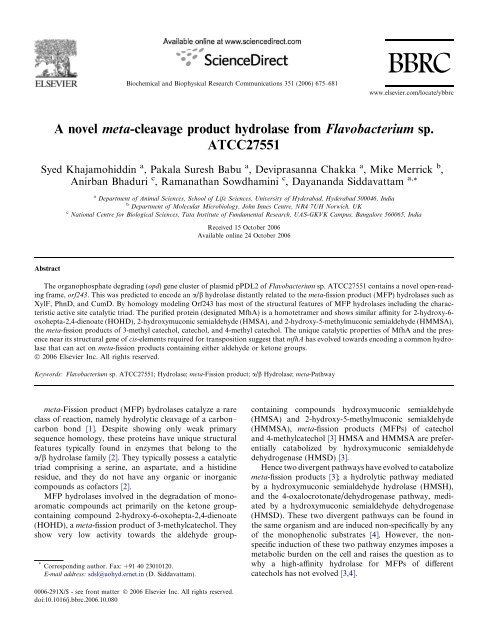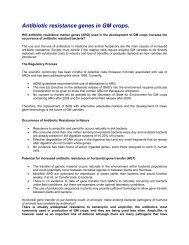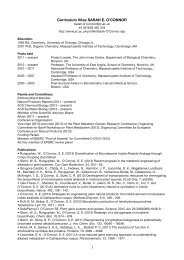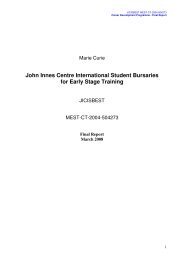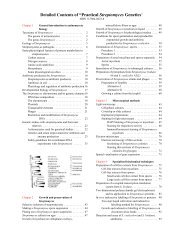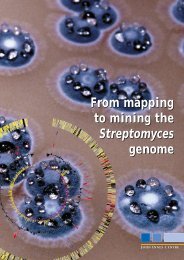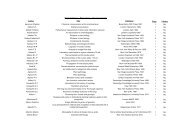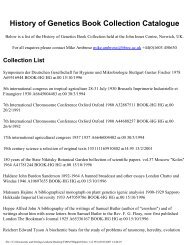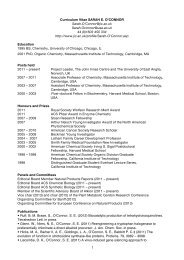A novel meta-cleavage product hydrolase from Flavo - ResearchGate
A novel meta-cleavage product hydrolase from Flavo - ResearchGate
A novel meta-cleavage product hydrolase from Flavo - ResearchGate
You also want an ePaper? Increase the reach of your titles
YUMPU automatically turns print PDFs into web optimized ePapers that Google loves.
Biochemical and Biophysical Research Communications 351 (2006) 675–681<br />
BBRC<br />
www.elsevier.com/locate/ybbrc<br />
A <strong>novel</strong> <strong>meta</strong>-<strong>cleavage</strong> <strong>product</strong> <strong>hydrolase</strong> <strong>from</strong> <strong>Flavo</strong>bacterium sp.<br />
ATCC27551<br />
Syed Khajamohiddin a , Pakala Suresh Babu a , Deviprasanna Chakka a , Mike Merrick b ,<br />
Anirban Bhaduri c , Ramanathan Sowdhamini c , Dayananda Siddavattam a, *<br />
a Department of Animal Sciences, School of Life Sciences, University of Hyderabad, Hyderabad 500046, India<br />
b Department of Molecular Microbiology, John Innes Centre, NR4 7UH Norwich, UK<br />
c National Centre for Biological Sciences, Tata Institute of Fundamental Research, UAS-GKVK Campus, Bangalore 560065, India<br />
Received 15 October 2006<br />
Available online 24 October 2006<br />
Abstract<br />
The organophosphate degrading (opd) gene cluster of plasmid pPDL2 of <strong>Flavo</strong>bacterium sp. ATCC27551 contains a <strong>novel</strong> open-reading<br />
frame, orf243. This was predicted to encode an a/b <strong>hydrolase</strong> distantly related to the <strong>meta</strong>-fission <strong>product</strong> (MFP) <strong>hydrolase</strong>s such as<br />
XylF, PhnD, and CumD. By homology modeling Orf243 has most of the structural features of MFP <strong>hydrolase</strong>s including the characteristic<br />
active site catalytic triad. The purified protein (designated MfhA) is a homotetramer and shows similar affinity for 2-hydroxy-6-<br />
oxohepta-2,4-dienoate (HOHD), 2-hydroxymuconic semialdehyde (HMSA), and 2-hydroxy-5-methylmuconic semialdehyde (HMMSA),<br />
the <strong>meta</strong>-fission <strong>product</strong>s of 3-methyl catechol, catechol, and 4-methyl catechol. The unique catalytic properties of MfhA and the presence<br />
near its structural gene of cis-elements required for transposition suggest that mfhA has evolved towards encoding a common <strong>hydrolase</strong><br />
that can act on <strong>meta</strong>-fission <strong>product</strong>s containing either aldehyde or ketone groups.<br />
Ó 2006 Elsevier Inc. All rights reserved.<br />
Keywords: <strong>Flavo</strong>bacterium sp. ATCC27551; Hydrolase; <strong>meta</strong>-Fission <strong>product</strong>; a/b Hydrolase; <strong>meta</strong>-Pathway<br />
* Corresponding author. Fax: +91 40 23010120.<br />
E-mail address: sdsl@uohyd.ernet.in (D. Siddavattam).<br />
<strong>meta</strong>-Fission <strong>product</strong> (MFP) <strong>hydrolase</strong>s catalyze a rare<br />
class of reaction, namely hydrolytic <strong>cleavage</strong> of a carbon–<br />
carbon bond [1]. Despite showing only weak primary<br />
sequence homology, these proteins have unique structural<br />
features typically found in enzymes that belong to the<br />
a/b <strong>hydrolase</strong> family [2]. They typically possess a catalytic<br />
triad comprising a serine, an aspartate, and a histidine<br />
residue, and they do not have any organic or inorganic<br />
compounds as cofactors [2].<br />
MFP <strong>hydrolase</strong>s involved in the degradation of monoaromatic<br />
compounds act primarily on the ketone groupcontaining<br />
compound 2-hydroxy-6-oxohepta-2,4-dienoate<br />
(HOHD), a <strong>meta</strong>-fission <strong>product</strong> of 3-methylcatechol. They<br />
show very low activity towards the aldehyde groupcontaining<br />
compounds hydroxymuconic semialdehyde<br />
(HMSA) and 2-hydroxy-5-methylmuconic semialdehyde<br />
(HMMSA), <strong>meta</strong>-fission <strong>product</strong>s (MFPs) of catechol<br />
and 4-methylcatechol [3] HMSA and HMMSA are preferentially<br />
catabolized by hydroxymuconic semialdehyde<br />
dehydrogenase (HMSD) [3].<br />
Hence two divergent pathways have evolved to catabolize<br />
<strong>meta</strong>-fission <strong>product</strong>s [3]; a hydrolytic pathway mediated<br />
by a hydroxymuconic semialdehyde <strong>hydrolase</strong> (HMSH),<br />
and the 4-oxalocrotonate/dehydrogenase pathway, mediated<br />
by a hydroxymuconic semialdehyde dehydrogenase<br />
(HMSD). These two divergent pathways can be found in<br />
the same organism and are induced non-specifically by any<br />
of the monophenolic substrates [4]. However, the nonspecific<br />
induction of these two pathway enzymes imposes a<br />
<strong>meta</strong>bolic burden on the cell and raises the question as to<br />
why a high-affinity <strong>hydrolase</strong> for MFPs of different<br />
catechols has not evolved [3,4].<br />
0006-291X/$ - see front matter Ó 2006 Elsevier Inc. All rights reserved.<br />
doi:10.1016/j.bbrc.2006.10.080
676 S. Khajamohiddin et al. / Biochemical and Biophysical Research Communications 351 (2006) 675–681<br />
We now report that the open-reading frame, orf243,<br />
encoded in the organophosphate degrading (opd) gene cluster<br />
of plasmid pPDL2 of <strong>Flavo</strong>bacterium sp. ATCC27551<br />
encodes an MFP <strong>hydrolase</strong> that shows high affinity for<br />
both ketone and aldehyde group-containing <strong>meta</strong>-fission<br />
<strong>product</strong>s. We have consequently designated this open-reading<br />
frame mfhA (<strong>meta</strong>-fission <strong>hydrolase</strong> A).<br />
Materials and methods<br />
Bacterial strains and culture conditions. Cultures of Escherichia coli and<br />
Pseudomonas aeruginosa PAO1161 were grown in LB medium at 37 °C<br />
and 30 °C, respectively. When necessary, antibiotics such as ampicillin<br />
(100 lg/ml), chloramphenicol (30 lg/ml), and kanamycin (25 lg/ml) were<br />
added to the growth medium.<br />
Construction of plasmids. To express MfhA with an N-terminal His-tag<br />
in E. coli, the structural gene, mfhA, was amplified <strong>from</strong> pSM2 [5] using a<br />
5 0 primer 5 0 CGCGGATCCATGGCGCATGCCCGCGTTC3 0 with a<br />
BamHI site (in bold type) and a 3 0 primer 5 0 GCCCTGCAGCT<br />
GTGACTAACCCGGCGCGG3 0 . The PCR <strong>product</strong> was cloned into<br />
pRSETA (Invitrogen) using BamHI to give pSM12. To express mfhA in P.<br />
aeruginosa [6], it was cloned in a broad-host-range vector, pMMB206 [7].<br />
The gene was amplified <strong>from</strong> pSM12 using the primer 5 0 AACAAGATC<br />
TAGGGAGACCACAACGGTTTCCC3 0 with a BglII restriction site (in<br />
bold type) and a T7 terminator primer. The PCR <strong>product</strong> was digested<br />
with BglII and cloned in pMMB206 digested with BamHI. A recombinant<br />
plasmid with the correct insert orientation was designated pSM13. The<br />
plasmid pSM13 was mobilized into P. aeruginosa by following standard<br />
protocols [8] and the presence of plasmid in exconjugants was confirmed<br />
by the method of Kado and Liu [9].<br />
Expression and purification of MfhA. Overexpression of mfhA in E.coli<br />
BL21(DE3) [10] or in P. aeruginosa was carried out in LB medium. One<br />
millimolar IPTG was added to a culture at an OD 600 of 0.5 and 2 h later<br />
induction of MfhA was monitored using 12.5% SDS–PAGE. The cell<br />
pellet was resuspended in 50 mM sodium phosphate buffer, pH 7.2, containing<br />
0.5 M NaCl and lysed by a freeze–thaw method [11,14]. The soluble<br />
fraction containing the expressed protein was used for further<br />
purification. As MfhA contains N-terminal his-tag the protein was affinity<br />
purified using Hi-Trap chelating affinity column (Amersham Biosciences)<br />
following manufacturers, protocols. Active fractions were pooled and<br />
analyzed on 12.5% SDS–PAGE to assess purity and subunit molecular<br />
weight. The molecular mass of native MfhA was estimated by gel-filtration<br />
chromatography using Sephacryl S-200 (75 · 1.5 cm). Blue dextran<br />
(2000 kDa), Alcohol dehydrogenase (150 kDa), b-galactosidase (116 kDa),<br />
and albumin (67 kDa) were used as molecular size markers.<br />
Enzyme assays. MfhA activity was determined at 28 °C in 100 mM<br />
sodium phosphate buffer (pH 7.5), using a 1 ml reaction volume<br />
containing appropriate concentrations of MFPs of catechol (HMSA),<br />
3-methylcatechol (HOHD), and 4-methylcatechol (HMMSA). The reaction<br />
was initiated by addition of pure MfhA and the decrease in absorbance<br />
at wavelength 389 nm (HOHD), 376 nm (HMSA), and 382 nm<br />
(HMMSA) was recorded. The molar extinction coefficients used for <strong>meta</strong><strong>cleavage</strong><br />
<strong>product</strong>s HOHD, HMSA, and HMMSA were 11.9 mM 1 cm 1 ,<br />
40.0 mM 1 cm 1 , and 24.5 mM 1 cm 1 , respectively [30]. The MFPs were<br />
prepared fresh daily using E.coli DH5a (pWW0-6000) and procedures<br />
described elsewhere [13].<br />
Kinetic properties of MfhA. The steady-state kinetic properties of<br />
MfhA were determined using MFPs HOHD, HMSA, and HMMSA as<br />
substrates at concentrations over the range of 1–50 lM in 100 mM sodium<br />
phosphate buffer (pH 7.5) at 28 °C. The enzyme concentration was<br />
adjusted so that the reaction was linear for at least 2 min and six independent<br />
experiments were carried out at each concentration for each<br />
substrate. Kinetic parameters were calculated using Graphpad prism<br />
software (www.graphpad.com). One unit of enzyme activity was defined as<br />
the amount of enzyme required to convert 1 lmole of substrate per min.<br />
To estimate the optimum pH for MfhA, the enzyme activity was measured<br />
over a pH range of 6.0–10.0 in 50 mM Na 2 HPO 4 (pH 6–8) buffer or<br />
50 mM Tris (pH 8–10). The molar extinction coefficient of MFPs at different<br />
pH was taken as described elsewhere [37]. The effect of temperature<br />
on enzyme activity was measured by varying the temperature <strong>from</strong> 5 to<br />
85 °C in 50 mM sodium phosphate buffer (pH 7.5). The effect of <strong>meta</strong>l ions<br />
on MfhA activity was determined using a 10 lM concentration of chloride,<br />
sulfate or nitrate salts of Fe 2+ ,Ca 2+ ,Cu 2+ ,Mg 2+ ,Mn 2+ ,Co 2+ ,Li 2+ ,<br />
and Zn 2+ . The effects of chelating agents such as EDTA and group-specific<br />
inhibitors such as PMSF, DEPC, N-ethylmaleimide and, p-chloromercuribenzoate<br />
on MfhA activity were all assessed using a concentration<br />
of 10 lM.<br />
Modeling the structure of MfhA. Threefold prediction methods, Gen-<br />
Threader [15], hybrid fold prediction [16], and 3DPSSM [17], were considered<br />
for structure prediction. Homology modeling was performed using<br />
MODELLER [18] starting <strong>from</strong> the best structural template. Models<br />
generated were validated using VERIFY3D [19] and the best model was<br />
selected. Structure-annotation was performed on the sequence alignment<br />
between query and template using the program JOY [20]. Interactions<br />
with possible ligands were simulated using the docking program,<br />
GRAMM [21,22], which predicts structure of the complex formed by<br />
using their atomic coordinates without any prior information as to their<br />
binding sites. Structural comparisons were performed after best fit using<br />
SUPER [23]. The electrostatic surface representations were projected<br />
using GRASP [24].<br />
Results and discussion<br />
Structural modeling of MfhA<br />
Our previous studies suggested that orf243 (mfhA),<br />
encoded in the organophosphate degrading (opd) gene cluster<br />
of plasmid pPDL2 of <strong>Flavo</strong>bacterium sp. ATCC27551,<br />
encodes an a/b <strong>hydrolase</strong> somewhat distantly related to<br />
MFP <strong>hydrolase</strong>s such as XylF, PhnD, and CumD [5]. A<br />
dendrogram for known MFP-<strong>hydrolase</strong>s shows MfhA is<br />
very distantly related to the rest of the MFP-<strong>hydrolase</strong>s<br />
(Fig. 1), creating a new subfamily, designated as subfamily<br />
IV based on the classification described previously [25].<br />
Given this distant relationship to MFP-<strong>hydrolase</strong>s we<br />
undertook structural modeling of MfhA to examine<br />
whether it has all the expected features of this protein family.<br />
All threefold prediction methods suggested an a/b<br />
<strong>hydrolase</strong> as the most probable fold with high confidence<br />
(90% probability). A <strong>meta</strong>-<strong>cleavage</strong> <strong>product</strong> <strong>hydrolase</strong>,<br />
CumD, <strong>from</strong> Pseudomonas fluorescens (PDB code: 1iuo)<br />
was the best template, with the highest score for compatibility<br />
of structure (lowest e-value) according to 3DPSSM.<br />
CumD was therefore used as the template for modeling<br />
the putative <strong>hydrolase</strong>. Alignment of MfhA with the template<br />
sequence (see Fig. 2) confirmed our earlier predictions<br />
[5] that residues Ser58, Asp183, and His215 were likely candidates<br />
for the catalytic triad residues of the enzyme.<br />
The structure of CumD was therefore used as the template<br />
for modeling and the resultant MfhA model<br />
(Fig. 3A), which was validated using the HARMONY<br />
webserver (Fig. 3B) [35], showed very good agreement with<br />
the 3D structure of CumD [26]. It has the distinctive core<br />
and lid domains characteristic of the MFP <strong>hydrolase</strong>s<br />
[27] and the predicted catalytic triad residues, Ser58,<br />
Asp183, and His215 [5], are indeed located within the
S. Khajamohiddin et al. / Biochemical and Biophysical Research Communications 351 (2006) 675–681 677<br />
Fig. 1. Phylogenetic Tree of the <strong>meta</strong>-fission <strong>product</strong> <strong>hydrolase</strong>s. Tree was constructed by the neighbor-joining method by aligning the sequences of 52<br />
MFP-<strong>hydrolase</strong>s. MFP-<strong>hydrolase</strong>s were grouped into four subfamilies. MfhA is shown as part of subfamily IV and is shown in a box. Scale represents<br />
distance expressed as percentage of divergence. Bootstrap values are not shown. GenBank accession numbers for MFP-<strong>hydrolase</strong>s are shown after the<br />
enzyme name.<br />
potential substrate-binding pocket between those domains.<br />
As coordinates of the precise substrates of MfhA (HOHD,<br />
HMSA, and HMMSA) were not available we probed the<br />
interaction of the protein with coordinates of the related<br />
molecules catechol, 3-methylcatechol, and 4-methylcatechol,<br />
using GRAMM. In each instance, facile docking<br />
was observed in the vicinity of the putative active site<br />
and the <strong>meta</strong>-fission <strong>product</strong>s of these molecules could be<br />
expected to behave similarly.<br />
Despite high structural similarity between CumD and<br />
MfhA, the cavities at the substrate-binding site (interface<br />
between core and lid regions) are rather different when projected<br />
by surface representation (Fig. 4). The cavities in the<br />
MfhA model are more pronounced owing to several residue<br />
differences. For instance, the residue immediately after<br />
the active site near the glycine-rich loop is Phe in CumD<br />
but is replaced by a smaller residue (Ala) in MfhA. Perhaps,<br />
additional interactions are required between Phe<br />
and methyl groups of the substrate in CumD. Furthermore,<br />
the electrostatics distributions in the two proteins<br />
are remarkably different (Fig. 4) indicating that their interactions<br />
with other protein molecules could be distinct.<br />
Whereas CumD is highly negatively charged (total charge<br />
= 12) (Fig. 4A), MfhA is slightly positively charged<br />
(total charge = +1) (Fig. 4B) as measured using GRASP<br />
[24].<br />
When compared to some other MFP <strong>hydrolase</strong>s, apparently<br />
MfhA is truncated at the N-terminus (Fig. 2). As a<br />
consequence the first three b-strands seen in CumD are<br />
absent <strong>from</strong> MfhA. However, the absence of these three<br />
b-strands in this superfamily is not uncommon. We find<br />
that nearly one-fourth of the structural entries at 40%<br />
sequence identity cut-off in this superfamily, as recorded<br />
in PASS2 database [28], are shorter and can be aligned<br />
without the N-terminal peripheral beta-strands. These<br />
include nine PDB entries, 1ehya (epoxide <strong>hydrolase</strong>),<br />
1ei9a (palmitoyl thioesterase), 1fj2a (acyl thioesterase),<br />
1i6wa (lipase A), 1qj4A (hydroxynitrile lyase), 1auoA<br />
(carboxylesterase), 1brt (bromoperoxidase A2), 1c4x<br />
(BPHD), and 1cvl (triacylglycerol <strong>hydrolase</strong>).<br />
Heterologous expression of MfhA<br />
Overexpression of MfhA with an N-terminal His-tag<br />
was carried out using pSM12 in E. coli BL21(DE3). A<br />
30 kDa band was observed only in IPTG-induced cultures<br />
but most of the expressed protein was found in the particulate<br />
fraction indicating that MfhA was accumulated in<br />
inclusion bodies (data not shown). Attempts were made<br />
to reconstitute active enzyme by solubilizing the inclusion<br />
bodies in the denaturing agents 8 M urea or 8 M sodium<br />
lauroylsarcosine followed by dialysis in progressively
678 S. Khajamohiddin et al. / Biochemical and Biophysical Research Communications 351 (2006) 675–681<br />
Fig. 2. Alignment between MfhA and the P. fluorescens CumD <strong>hydrolase</strong> (PDB code: 1iuo) employed as the template for modeling. The alignment has<br />
been structure-annotated using JOY [20] where upper case, lower case, blue text, and red text denote solvent-buried, solvent accessible, helical, and b-<br />
strands, respectively. Hydrogen bonds to main chain amide, main chain carbonyl are marked by bold and underline, respectively. Residues with positivephi<br />
are marked in italics. The catalytic residues are indicated with yellow boxes and the lid region is marked in pale blue. Regions (1–4) of significant<br />
insertion or deletion are indicated. (For interpretation of the references to color in this figure legend, the reader is referred to the web version of this paper.)<br />
Fig. 3. (A) Overlay of the MfhA modeled structure with the known structure of the CumD <strong>meta</strong>-fission <strong>product</strong> <strong>hydrolase</strong> <strong>from</strong> P. fluorescens (PDB code:<br />
1iuo). CumD is shown in blue and MfhA in green. Major regions of difference identified <strong>from</strong> the initial alignment (Fig. 2) are indicated as are the active<br />
site residues of MfhA (S58, D183, H215). (B) Structure validation of MfhA model using HARMONY webserver [35]. HARMONY validation scores are<br />
mapped on the structure using MOLSCRIPT [36]. Red and orange colored regions indicate possible local errors in the structure. (For interpretation of the<br />
references to color in this figure legend, the reader is referred to the web version of this paper.)
S. Khajamohiddin et al. / Biochemical and Biophysical Research Communications 351 (2006) 675–681 679<br />
Fig. 4. Electrostatic surface representation of (A) CumD and (B) the MfhA model. View <strong>from</strong> the ‘‘top’’ surface of the proteins with the ‘‘lid’’ on the top.<br />
Figure generated using GRASP [24].<br />
decreased concentrations of these agents [11]. Whilst some<br />
MfhA was then found to be soluble, suggesting successful<br />
refolding, this protein showed no catalytic activity when<br />
HOHD, HMSA, and HMMSA were used as substrates.<br />
Interestingly most of the MfhA encoded by the plasmid<br />
pSM13 in P. aeruginosa PAO1161 was not only found to<br />
be in soluble form but also showed activity when the<br />
above-mentioned <strong>meta</strong>-fission <strong>product</strong>s were used as assay<br />
substrates.<br />
Biochemical properties of MfhA<br />
The molecular weight of MfhA was determined in denaturing<br />
and native conditions using SDS–PAGE and gel filtration<br />
chromatography, respectively. In denaturing<br />
conditions MfhA had a molecular weight of 27 kDa on<br />
SDS–PAGE [5] which was increased to 30 kDa by the<br />
N-terminal histidine tag used in this study. The molecular<br />
mass of MfhA was found to be 120 kDa by gel-filtration<br />
chromatography (data not shown), indicating that it is a<br />
homotetramer, a structure previously reported for other<br />
MFP-Hydrolases [29–31]. MfhA purified <strong>from</strong> P. aeruginosa<br />
successfully hydrolyzed <strong>meta</strong>-fission <strong>product</strong>s such as<br />
HOHD, HMSA, and HMMSA and it obeyed classic<br />
Michaelis-Menten kinetics for all of the substrates tested<br />
(data not shown). The apparent steady-state kinetic parameters<br />
were calculated <strong>from</strong> Lineweaver-Burk plots and are<br />
shown in Table 1. MfhA showed similar activities for<br />
HOHD and HMSA, and low activity towards HMMSA.<br />
The <strong>hydrolase</strong> activity had a pH optimum of 8.5 and<br />
when assessed over a temperature range of 5–85 °C using<br />
HOHD as substrate, it showed a maximum activity at<br />
75 °C, after which activity declined rapidly. At this temperature<br />
optimum MfhA lost just 21% of its activity after<br />
incubation for 2 h. MfhA activity was unaffected by divalent<br />
<strong>meta</strong>l ions like Fe 2+ , Ca 2+ , Cu 2+ , Mg 2+ , Mn 2+ ,<br />
Co 2+ ,Li 2+ ,andZn 2+ or by the chelating agent EDTA.<br />
However, activity was strongly inhibited by group-specific<br />
agents such as DEPC (82%) and PMSF (75%) suggesting<br />
the presence of serine and histidine as part of the catalytic<br />
residues. This is also in agreement with our earlier predictions<br />
that the residues Ser58, Asp183, and His215 could<br />
constitute the catalytic triad [5]. Consistent with the<br />
absence of cysteine residues in the deduced primary<br />
sequence, the thiol group modifying agents such as N-ethylmaleimide<br />
(7%) and p-chloromercuribenzoate (5%)<br />
showed no significant effect on enzyme activity. The<br />
enzyme showed no significant loss in activity when stored<br />
for 15 days at 4 °C or 20 °C in the presence of 20% glycerol,<br />
but after 30 days storage lost 20% activity at 20 °C,<br />
and 55% activity at 4 °C.<br />
MFP-<strong>hydrolase</strong>s are normally substrate specific, showing<br />
high activity towards ketone group-containing HOHD<br />
and low activity towards aldehyde group-containing<br />
HMSA and HMMSA [3,32]. By contrast MfhA shows similar<br />
affinities to both aldehyde and ketone group-containing<br />
MFPs; the K m s for HOHD, HMSA, and HMMSA being<br />
4.8, 5.7, and 7.4 lM, respectively (Table 1). As expected<br />
MfhA showed high activity with HOHD as a substrate<br />
but surprisingly also with HMSA as substrate. However,<br />
despite showing a high affinity towards HMMSA, MfhA<br />
had a relatively low activity with this substrate (Table 1).<br />
Nevertheless, the activity of MfhA towards HMMSA was<br />
considerably higher than those reported for other MFP
680 S. Khajamohiddin et al. / Biochemical and Biophysical Research Communications 351 (2006) 675–681<br />
Table 1<br />
Comparison of kinetic MFP-<strong>hydrolase</strong>s (involved in mono-aromatic compounds degradation) purified <strong>from</strong> various bacterial strains<br />
Enzyme Substrate K m (lM)<br />
h<br />
V max K cat (s 1 ) K cat /K m · 10 5 (M 1 s 1 ) Ref.<br />
XylF a HOHD 36 100 — — [12]<br />
HMSA 6.7 6.9 —<br />
HMMSA 10 3.2 — —<br />
HOHD b HOHD 6.7 100 — — [29]<br />
HMSA ND 7 — —<br />
HMMSA ND 3 — —<br />
HOHD c HOHD 27 100 — — [29]<br />
HMSA ND 3 — —<br />
HMMSA ND 1 — —<br />
EtbD1 d HOHD 4.5 100 — — [37]<br />
HMSA 20 24.4 — —<br />
HMMSA ND ND<br />
TodF e HOHD 17 (0.6) — 35 (0.5) 20 [30]<br />
HMSA 18 (0.5) — 2.2 (0.03) 1.2<br />
HMMSA 64 (2) — 2.1 (0.03) 0.3<br />
CumD f HOHD 9.0 (0.9) — 18 (1.8) 19 [38]<br />
MfhA g HOHD 4.8 (0.05) 100 57 (0.06) 119 This work<br />
HMSA 5.7 (0.3) 73 42 (0.3) 74<br />
HMMSA 7.4 (0.4) 28 16 (0.12) 27<br />
a From Pseudomonas putida mt-2.<br />
b From Pseudomonas putida NCIB 10015.<br />
c From Pseudomonas putida NCIB 9865.<br />
d From Rhodococcus sp. RHA1.<br />
e From Pseudomonas putida F1 (values taken <strong>from</strong> [30]).<br />
f From Pseudomonas fluorescens IP01.<br />
g At least six data points for the measurement of each substrate were collected. The turnover numbers for one subunit (K cat ) were calculated. Numerical<br />
values in parentheses indicate standard errors calculated <strong>from</strong> curve fitting.<br />
h Activities are expressed in percentage of specific activities on preferred substrate HOHD. ND, not detected.<br />
<strong>hydrolase</strong>s (Table 1). MFP-<strong>hydrolase</strong>s showing low activity<br />
towards HMMSA are not uncommon in the literature. In<br />
fact Henderson and Bugg have elegantly demonstrated that<br />
MFP-<strong>hydrolase</strong>s catalyze an enol–keto tautomerization of<br />
the substrate prior to hydrolysis [33]. In case of HMMSA,<br />
methyl substitution at position C5 provides stability to<br />
the enol-tautomer and thus it serves as poor substrate for<br />
<strong>meta</strong>-fission <strong>product</strong> <strong>hydrolase</strong>s [33].<br />
Like other MFP <strong>hydrolase</strong>s, and the HOHD <strong>hydrolase</strong>s<br />
<strong>from</strong> Pseudomonas putida NCIB 9865 and NCIB 10015<br />
[29], MfhA shows maximum activity at pH 8.5. However,<br />
the temperature optimum of MfhA of 75 °C is higher than<br />
that for other MFP <strong>hydrolase</strong>s [25,30].<br />
Significance of MfhA in the evolution of <strong>meta</strong>-fission<br />
<strong>hydrolase</strong>s<br />
To ensure further degradation, <strong>meta</strong>-fission <strong>product</strong>s are<br />
either hydrolyzed or dehydrogenated [3]. Degradation of<br />
aldehyde group-containing MFPs by the 4-oxalocrotonate<br />
pathway is considered to be an energy-yielding pathway<br />
due to the generation of reduced coenzyme NADH [34].<br />
However, for the generation of the common <strong>meta</strong>bolic<br />
intermediate 2-oxopent 4-enoate via the 4-oxalocrotonate<br />
pathway, the MFPs HMSA and HMMSA need to pass<br />
through three committed enzymatic steps [3,34]. Hence of<br />
the two potential degradation pathways the hydrolytic<br />
pathway appears to be the simpler, as it requires only<br />
one committed enzymatic step. In view of the catabolic<br />
divergence and non-specific induction of the enzymes<br />
involved in degradation of MFPs it has been proposed that<br />
it should be advantageous to have a unique <strong>hydrolase</strong> with<br />
an extended substrate range [3]. Considering its unique catalytic<br />
properties, MfhA is potentially an MFP-<strong>hydrolase</strong><br />
with the capability to degrade both aldehyde and ketone<br />
group-containing MFPs by channeling them into a simple<br />
hydrolytic pathway. Almost all MFP-<strong>hydrolase</strong>s are<br />
encoded within a <strong>meta</strong>-pathway operon. By contrast, mfhA<br />
is part of the plasmid-encoded opd gene cluster of <strong>Flavo</strong>bacterium<br />
sp. ATCC27551, a gene cluster that has features<br />
characteristic of horizontal transfer [5]. Though there is<br />
no experimental evidence, considering the presence of <strong>novel</strong><br />
direct and indirect repeats flanking mfhA, it is tempting<br />
to speculate that mfhA was recruited to the plasmid pPLD2<br />
through horizontal gene transfer, thereby diversifying the<br />
catabolic efficiency of its host.<br />
Acknowledgments<br />
We thank Dr. P. Williams for providing plasmid<br />
pWW0-6000. Work in the laboratory of D.S. is supported<br />
by DST, New Delhi, and ILS, Hyderabad. S.K. is grateful<br />
to CSIR, New Delhi, for providing Senior Research<br />
Fellowship.
S. Khajamohiddin et al. / Biochemical and Biophysical Research Communications 351 (2006) 675–681 681<br />
References<br />
[1] J.M. Horn, S. Harayama, K.N. Timmis, DNA sequence determination<br />
of the TOL plasmid (pWWO) xylGFJ genes of Pseudomonas<br />
putida: implications for the evolution of aromatic catabolism, Mol.<br />
Microbiol. 5 (1991) 2459–2474.<br />
[2] D.L. Ollis, E. Cheah, M. Cygler, B. Dijkstra, F. Frolow, S.M.<br />
Franken, M. Harel, S.J. Remington, I. Silman, J. Schrag, J.L.<br />
Sussman, K.H.G. Verscheuren, A. Goldman, The alpha/beta <strong>hydrolase</strong><br />
fold, Protein. Eng. 5 (1992) 197–211.<br />
[3] J.M. Sala-Trepat, K. Murray, P.A. Williams, The <strong>meta</strong>bolic divergence<br />
in the <strong>meta</strong> <strong>cleavage</strong> of catechols by Pseudomonas putida NCIB<br />
10015. Physiological significance and evolutionary implications, Eur.<br />
J. Biochem. 28 (1972) 347–356.<br />
[4] J.R. van der Meer, W.M. de Vos, S. Harayama, A.J. Zehnder,<br />
Molecular mechanisms of genetic adaptation to xenobiotic compounds,<br />
Microbiol. Rev. 56 (1992) 677–694.<br />
[5] D. Siddavattam, S. Khajamohiddin, B. Manavathi, S.B. Pakala, M.<br />
Merrick, Transposon-like organization of the plasmid-borne organophosphate<br />
degradation (opd) gene cluster found in <strong>Flavo</strong>bacterium sp,<br />
Appl. Environ. Microbiol. 69 (2003) 2533–2539.<br />
[6] K.D. Schmidt, B. Tummler, U. Romling, Comparative genome<br />
mapping of Pseudomonas aeruginosa PAO with P. aeruginosa C,<br />
which belongs to a major clone in cystic fibrosis patients and aquatic<br />
habitats, J. Bacteriol. 178 (1996) 85–93.<br />
[7] V.M. Morales, A. Backman, M. Bagdasarian, A series of wide-hostrange<br />
low-copy-number vectors that allow direct screening for<br />
recombinants, Gene 97 (1991) 39–47.<br />
[8] D.H. Figurski, D.R. Helinski, Replication of an origin containing<br />
derivative of plasmid RK2 dependent on a plasmid function provided<br />
in trans, Proc. Natl. Acad. Sci. USA 73 (1976) 1648–1652.<br />
[9] C.I. Kado, S.T. Liu, Rapid procedure for detection and isolation of<br />
large and small plasmids, J. Bacteriol. 145 (1981) 1365–1373.<br />
[10] F.W. Studier, B.A. Moffatt, Use of bacteriophage T7 RNA polymerase<br />
to direct selective high-level expression of cloned genes, J. Mol.<br />
Biol. 189 (1986) 113–130.<br />
[11] K. Tsumoto, D. Ejima, I. Kumagai, T. Arakawa, Practical considerations<br />
in refolding proteins <strong>from</strong> inclusion bodies, Protein Expr.<br />
Purif. 28 (2003) 1–8.<br />
[12] C.J. Duggleby, P.A. Williams, Purification and some properties of 2-<br />
hydroxy-6-oxo-2,4-heptadienoate <strong>hydrolase</strong> <strong>from</strong> two strains of<br />
Pseudomonas putida, J. Gen. Microbiol. 132 (1986) 717–726.<br />
[13] E. Diaz, K.N. Timmis, Identification of functional residues in a 2-<br />
hydroxymuconic semialdehyde <strong>hydrolase</strong>. A new member of the<br />
alpha/beta <strong>hydrolase</strong>-fold family of enzymes which cleaves carbon–<br />
carbon bonds, J. Biol. Chem. 270 (1995) 6403–6411.<br />
[14] C.H. Schein, M.H.M. Noteborn, Formation of soluble recombinant<br />
proteins in Escherichia coli is favoured by lower growth temperature,<br />
Biotechnology 6 (1988) 291–294.<br />
[15] D.T. Jones, GenTHREADER: an efficient and reliable protein fold<br />
recognition method for genomic sequences, J. Mol. Biol. 287 (1999)<br />
797–815.<br />
[16] D. Fischer, Hybrid fold recognition: combining sequence derived<br />
properties with evolutionary information, Pac. Symp. Biocomput.<br />
(2000) 119–130.<br />
[17] L.A. Kelley, R.M. MacCallum, M.J. Sternberg, Enhanced genome<br />
annotation using structural profiles in the program 3D-PSSM, J. Mol.<br />
Biol. 299 (2000) 499–520.<br />
[18] A. Sali, T.L. Blundell, Comparative protein modelling by satisfaction<br />
of spatial restraints, J. Mol. Biol. 234 (1993) 779–815.<br />
[19] D. Eisenberg, R. Luthy, J.U. Bowie, VERIFY3D: assessment of<br />
protein models with three-dimensional profiles, Methods Enzymol.<br />
277 (1997) 396–404.<br />
[20] K. Mizuguchi, C.M. Deane, T.L. Blundell, M.S. Johnson, J.P.<br />
Overington, JOY: protein sequence–structure representation and<br />
analysis, Bioinformatics 14 (1998) 617–623.<br />
[21] E. Katchalski-Katzir, I. Shariv, M. Eisenstein, A.A. Friesem, C.<br />
Aflalo, I.A. Vakser, Molecular surface recognition: determination of<br />
geometric fit between proteins and their ligands by correlation<br />
techniques, Proc. Natl. Acad. Sci. USA 89 (1992) 2195–2199.<br />
[22] I.A. Vakser, Protein docking for low-resolution structures, Protein<br />
Eng. 8 (1995) 371–377.<br />
[23] N. Srinivasan, Conformational analysis on globular proteins:data<br />
analysis. Molecular Biophysics Unit, Indian Institute of Science,<br />
Bangalore, India. Ref Type: Thesis/Dissertation, 1991.<br />
[24] A. Nicholls, K.A. Sharp, B. Honig, Protein folding and association:<br />
insights <strong>from</strong> the interfacial and thermodynamic properties of<br />
hydrocarbons, Proteins 11 (1991) 281–296.<br />
[25] M.J. Hernaez, E. Andujar, J.L. Rios, S.R. Kaschabek, W. Reineke, E.<br />
Santero, Identification of a serine <strong>hydrolase</strong> which cleaves the alicyclic<br />
ring of tetralin, J. Bacteriol. 182 (2000) 5448–5453.<br />
[26] S. Fushinobu, T. Saku, M. Hidaka, S.Y. Jun, H. Nojiri, H. Yamane,<br />
H. Shoun, T. Omori, T. Wakagi, Crystal structures of a <strong>meta</strong><strong>cleavage</strong><br />
<strong>product</strong> <strong>hydrolase</strong> <strong>from</strong> Pseudomonas fluorescens IP01<br />
(CumD) complexed with <strong>cleavage</strong> <strong>product</strong>s, Protein Sci. 11 (2002)<br />
2184–2195.<br />
[27] N. Nandhagopal, A. Yamada, T. Hatta, E. Masai, M. Fukuda, Y.<br />
Mitsui, T. Senda, Crystal structure of 2-hydroxyl-6-oxo-6-phenylhexa-2,4-dienoic<br />
acid (HPDA) <strong>hydrolase</strong> (BphD enzyme) <strong>from</strong> the<br />
Rhodococcus sp. strain RHA1 of the PCB degradation pathway, J.<br />
Mol. Biol. 309 (2001) 1139–1151.<br />
[28] A. Bhaduri, L. Krishnaswamy, G.R. Ullal, M.R. Panicker, R.<br />
Sowdhamini, Fold prediction and comparative modeling of Bdm1:<br />
a probable alpha/beta <strong>hydrolase</strong> associated with hot water epilepsy, J.<br />
Mol. Model. (Online) 9 (2003) 3–8.<br />
[29] R.C. Bayly, B.D. Di, Purification and properties of 2-hydroxy-6-oxo-<br />
2,4-heptadienoate <strong>hydrolase</strong> <strong>from</strong> two strains of Pseudomonas putida,<br />
J. Bacteriol. 134 (1978) 30–37.<br />
[30] S.Y. Seah, G. Terracina, J.T. Bolin, P. Riebel, V. Snieckus, L.D. Eltis,<br />
Purification and preliminary characterization of a serine <strong>hydrolase</strong><br />
involved in the microbial degradation of polychlorinated biphenyls, J.<br />
Biol. Chem. 273 (1998) 22943–22949.<br />
[31] K. Furukawa, J. Hirose, A. Suyama, T. Zaiki, S. Hayashida, Gene<br />
components responsible for discrete substrate specificity in the<br />
<strong>meta</strong>bolism of biphenyl (bph operon) and toluene (tod operon), J.<br />
Bacteriol. 175 (1993) 5224–5232.<br />
[32] S. Harayama, N. Mermod, M. Rekik, P.R. Lehrbach, K.N. Timmis,<br />
Roles of the divergent branches of the <strong>meta</strong>-<strong>cleavage</strong> pathway in the<br />
degradation of benzoate and substituted benzoates, J. Bacteriol. 169<br />
(1987) 558–564.<br />
[33] I.M. Henderson, T.D. Bugg, Pre-steady-state kinetic analysis of 2-<br />
hydroxy-6-keto-nona-2,4-diene-1,9-dioic acid 5,6-<strong>hydrolase</strong>: kinetic<br />
evidence for enol/keto tautomerization, Biochemistry 36 (1997)<br />
12252–12258.<br />
[34] K. Murray, C.J. Duggleby, J.M. Sala-Trepat, P.A. Williams, The<br />
<strong>meta</strong>bolism of benzoate and methylbenzoates via the <strong>meta</strong>-<strong>cleavage</strong><br />
pathway by Pseudomonas arvilla mt-2, Eur. J. Biochem. 28 (1972)<br />
301–310.<br />
[35] G. Pugalenthi, K. Shameer, N. Srinivasan, R. Sowdhamini, HAR-<br />
MONY: a web-server for the assessment of protein structures,<br />
Nucleic Acids Res. 34 (2006) W231–W234.<br />
[36] P.J. Kraulis, Molscript – a program to produce both detailed and<br />
schematic plots of protein structures, J. Appl. Crystal. 24 (1991) 946–<br />
950.<br />
[37] T. Hatta, T. Shimada, T. Yoshihara, A. Yamada, E. Masi, M.<br />
Fukuda, H. Kiyohara, <strong>meta</strong>-Fission <strong>product</strong> <strong>hydrolase</strong>s <strong>from</strong> a strong<br />
PCB degrader Rhodococcus sp. RHA1, J. Ferment. Bioeng. 85 (1998)<br />
174–179.<br />
[38] T. Saku, S. Fushinobu, S.Y. Jun, N. Ikeda, H. Nojiri, H. Yamane, T.<br />
Omori, T. Wakagi, Purification, characterization, and steady-state<br />
kinetics of a <strong>meta</strong>-<strong>cleavage</strong> compound <strong>hydrolase</strong> <strong>from</strong> Pseudomonas<br />
fluorescens IPO1, J. Biosci. Bioeng. 93 (2002) 568–574.


